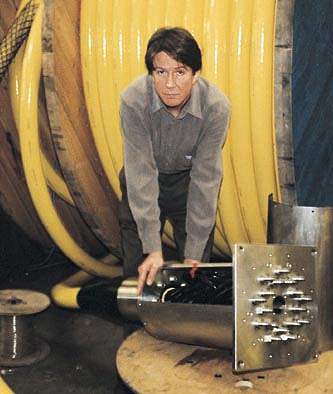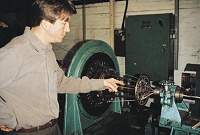 The mysterious but essential art of umbilical manufacture is carried out in relative secrecy at little-known locations. UCI editor John Bevan traced one of the world's leading suppliers to a small town, code-named Hoddesdon, somewhere north of Junction 25 of the M25, on the Aberdeen side of London. My tour around the manufacturing facilities at Cortland Fibron BX Ltd's (CFBX) Hoddesdon factory, courtesy of Managing Director Neil McAdam, proved fascinating. "CFBX was founded in 1986 and has become one of the leading suppliers of not only hoses, but also cables and a huge variety of special-purpose umbilicals for the subsea industry," Neil McAdam explained. "In February 2000 the company was acquired by The Cortland Companies and a new management team was put in place. Since then, there has been a major emphasis on innovation and the introduction of new materials and technologies. We received our ISO 9001 certification last December. "As well as our traditional umbilicals for the diving industry, we now supply the geophysical survey market (airgun umbilicals, tow cables, ocean bottom cables and lead-in cables), the ROV operators (tethers, main lift cables and subsea crawler cables), the oil and gas operators (workover, intervention and maintenance umbilicals, product and system control umbilicals, installation and completion umbilicals), and the defence industry (tow cables, range cables and submarine rescue cable and umbilicals)." Poised The company has outgrown its present site and is poised to expand threefold in manufacturing space. It is currently searching for a facility of approximately 50,000 sq ft. This will give a chance for the current staff to meet the increasing customer demands. And demanding is what CFBX customers certainly are. Most of them want products strictly to their own specification. As Neil says: "90% of our products are to client specifications". However, the constantly changing client requirements mean that innovation is a continuous requirement - and this has clearly contributed to the success of the company.  I had always been curious about how hoses and umbilicals were made, so it was a real eye-opener to see the various machines starting with the raw materials at one end and the hose or umbilical squirting out at the other end.
I had always been curious about how hoses and umbilicals were made, so it was a real eye-opener to see the various machines starting with the raw materials at one end and the hose or umbilical squirting out at the other end.There were machines for braiding where the strength fibres were intertwined over the hose, extruding machines where intermediate or final layers were added, and 20ft-tall laying up machines which wound the umbilical bundles together. Meanwhile, another large machine buzzed away with 30 bobbins pirouetting on a carousel turning out 3 kilometres of seismic cable at a time. Alongside, a quading machine was laying up small electrical cable bundles. Colour-coded The diver umbilical hoses made several journeys through the braiding and extrusion machines, each time acquiring another layer. The last layer is specially colour-coded so that the function of each hose or cable can be easily identified. In their surface-diving umbilical bundles, for example, the 1/4-inch pneumo hose is yellow, the 3/8-inch gas hose is blue, the 1/2-inch hot water hose is red, the 2-pair electrical communications cable is orange and the co-axial video cable is red. The main strength member is the comms cable, which has a design breaking strain of 500kg.
In addition to the usual sheathing compounds, such as polyethylene, polyurethane and other proprietary materials, another significant innovation has been the recent introduction of a unique lightweight sheathing compound with a specific gravity of only 0.78, and they continue to work to improve this figure. Patented CFBX has recently patented a cable design called HAVLES that can operate at 6.6kV to 15kV AC, using standard processing technology and bringing a commercially attractive, safer and more reliable product to the industry. This offers real advantages to subsea cable and umbilical users. Neil had some interesting observations on the activity levels within the various sectors of the subsea industry. "We have seen a steady increase in the volume of business over the past two years, and this increase is spread evenly across the spectrum of product that we offer, and we expect this to continue. This is confirmation of our success in bringing new design and technology to the market place, whilst maintaining our corporate goal for high levels of customer service. "The diving industry has been growing over the past two years. We have had increasing orders from West Africa, the Gulf of Mexico and the Far East. "Seventy per cent of our sales are for export. On the downside, products for the fibre-optic cable burial industry have suddenly dwindled in the last year." CFBX has a close working relationship with several other local companies. These provide specialist services and manufacturing to complement those within CFBX. Hydraulic  Among these are Scorpion Oceanics Ltd, who provide specialist hydraulic hose, electrical termination design and fabrication facilities, and Bridon International Ltd, who provide the torque-balanced steel wire armouring for the complete range of products.
Among these are Scorpion Oceanics Ltd, who provide specialist hydraulic hose, electrical termination design and fabrication facilities, and Bridon International Ltd, who provide the torque-balanced steel wire armouring for the complete range of products. It was a real education to be shown around the CFBX manufacturing facilities. My tour revealed many of the secrets and dispelled many of my misconceptions of this important but little-known industry. I came away with a much greater respect for the massive technical effort behind the development of umbilical components. It is easy to take umbilicals for granted, perhaps because they are so reliable. But diver and bell umbilicals, for example, are critical components of a life-support system. They demand the same quality control as every other component. Equally, huge investments are made in geophysical surveys, and all that data ends up being transmitted through cables. Reliability is absolutely essential. The management team at CBFX are unusually pro-active and helpful. This has to be because nearly all their products are tailored to each individual client. You can do no worse than give them a call any time you have a cable or umbilical requirement. |
© 2002 Underwater World Publications Ltd.


